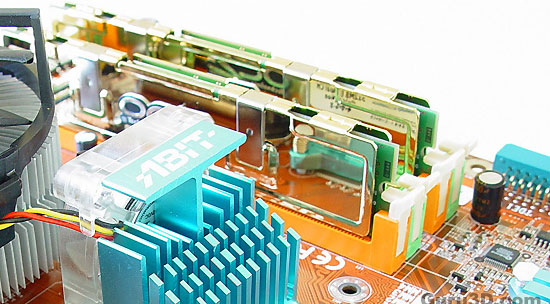Page 2
We'll start off with the abc's of memory.
First remember this, Pentium 4 processors really are dependant on memory bandwidth, the faster the better. Something that is by far not as important for AMD processors. In an ideal situation the memory should be clocked as fast as your FSB to gain optimal bandwidth. Unfortunately it's very tough and expensive to have memory clocked at that speed, the technology isn't quite there yet. Today's memory is high-end, yet we are restricted at 667 MHz.
When you recently bought a PC, or for that matter are buying a new system you'll notice that most PC's make use of DDR400 (PC3200) memory. It's the most commonly used type as this memory matches your PC's CPU bus speed. That CPU bus speed, also known as "front-side bus speed" (or FSB), is the speed at which the CPU communicates with RAM memory and the motherboard chipset. Athlon XPs have a 266, 333 or 400 MHz FSB, Pentium 4s have a 400MHz, 533MHz or 800MHz and the newer 1066 MHz FSB, AMD Durons have a 200MHz FSB and socket 478 Celerons have a 400MHz FSB and so on and so on.
When choosing a FSB speed for the CPU you choose, be aware that you'll need to purchase memory capable of this faster speed. For example, many people are enticed by the remarkably low priced memory, yet you need to sync your memory to your CPU's FSB. First of all, all mainboard these days use either DDR or DDR2 memory, the mainboard we used needs DDR2 memory. In our case we know that the CPU we have uses the 800 MHz bus so we're gonna need DDR2 memory rated PC3200 at the bare minimum, thus 400 MHz DDR memory that is capable of handling that FSB. Just divide the CPU FSB by 2 and you are set to go for regular usage.
But ... in our case we want to make make use of 533 MHz DDR memory as we are going to overclock (increase the FSB). Why DDR533 ? Simple, the platform we'll use today is equipped a Pentium 4 based platform at 3.6 GHz. Fortunately for us the processor is unlocked and we can can de-/increase the, there is the magic word again, FSB. The Pentium 4 processor my friends uses a quad pumped bus as Intel calls it so nicely. A 800 MHz FSB sounds better then 4x200 MHz. When you start fooling around with that FSB you better make sure you have some really good memory as the increased FSB will have a huge impact on the memory also.
Secondly, always make sure you buy two bars so that you can have a dual-channel memory configuration, which effectively double's the memory bandwidth and the Pentium 4 loves that bandwidth for sure. Allow me to introduce the a picture of this RAM..
Third factor you should take into account (if you are going to overclock) is to get buy a mainboard that can increase the voltage level of your memory significantly, also it should offer you scalability not only in on that FSB, but also offers you a choice in multipliers & dividers.
With multipliers at BIOS level you can alter the frequency of the memory. For example if you have a 200 MHz FSB then a multiplier of 1:1 would be good under normal circumstances as it would offer you 2x200=400 MHz DDR. But take that same 200 MHz FSB with an optional multiplier of let's say ... 3:2 .. (200x3):2 = 300 MHz (x2 DDR) .. hmm that's a third more extra memory bandwidth instantly ! Now if you slowly raise that FSB combined with the proper divider/multipliers you can imaging you can get some extra bandwidth or better overclocking potential, thing is .. you'll need memory that can rise along with that FSB.

Judging from the specifications, OCZ modules always love voltage, when you start to overclock you'll need to raise that voltage at BIOS level. If you want to run it at nominal speed it already is recommended to set your DDR voltage at 1.8 or 1.9 volts. You can image that when you start to overclock that voltage level needs to go up.
First, we will set the CPU at FSB800, the memory at 400 & 533Mhz with the help of the BIOS memory divider and the voltage at nominal 1.8V and run some tests. Next, we will increase the voltage for the memory modules to the maximum, 2.2V. Finally we will set the FSB speed to 1066 (266 MHz) and launch the memory modules to the 600-700 Mhz range to see if it can cope with that speed.
Specifications:
- 667MHz DDR2
- CL 4-4-4-8 (CAS-TRCD-TRP-TRAS)
- 1GB (2X512) and 2GB (2X1024) dual channel optimized kits
- Unbuffered
- Gold Mirrored Copper Heatspreader
- Lifetime Warranty
- 1.8 Volts
- 240 Pin DIMM
- 2.2V EVP - OCZ's unique Extended Voltage Protection feature allows PC2-5400 modules to handle voltages up to 2.2V ±5% and still be covered by our Lifetime Warranty.
What's rather interesting is that once you have installed the memory and fire up your rig, the SPD timings of this memory are not set standard at 4-4-4-7. Also interesting to know that at 533 MHz you can use a stable CAS3 with this memory.
